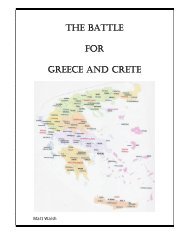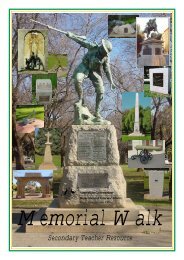Eastern Adelaide Teacher resource.pdf - Army Museum of South ...
Eastern Adelaide Teacher resource.pdf - Army Museum of South ...
Eastern Adelaide Teacher resource.pdf - Army Museum of South ...
You also want an ePaper? Increase the reach of your titles
YUMPU automatically turns print PDFs into web optimized ePapers that Google loves.
Consider both the practical and symbolic significance <strong>of</strong> the choice <strong>of</strong> this type <strong>of</strong><br />
war memorial.<br />
The headmaster probably thought that as it was former students who served in World<br />
War I that it was most fitting that current day students also build the memorial. No<br />
doubt the work involved in the construction <strong>of</strong> the war memorial would have<br />
promoted a sense <strong>of</strong> ownership and provided cause for reflection by the students on<br />
the contribution made by their predecessors in the Great War that might otherwise not<br />
have been the case.<br />
Obelisks are relatively easy to construct compared to other memorials such as those<br />
that involve carving human figures. They are high structures and therefore tend to<br />
stand out. Another practical advantage <strong>of</strong> obelisks is that they have at least four<br />
inscription faces. Obelisks have their origins in Egyptian, Greek and Roman<br />
architectural styles. The standard obelisk, <strong>of</strong> which the Norwood Primary school war<br />
memorial is a form, is shaped like a finger or ray <strong>of</strong> the sun. It is Egyptian in origin<br />
and originally represented “Ra” the Egyptian Sun God. Their symbolic significance as<br />
a choice for a war memorial lies in the fact that “Ra” was the giver <strong>of</strong> life. Pointing<br />
skywards also has connotations <strong>of</strong> being closer to God.<br />
36











